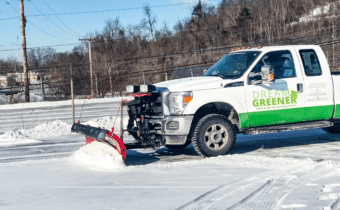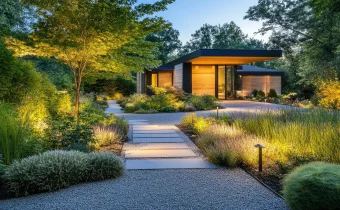At Dream Greener Lawn & Landscape, we believe that a well-maintained landscape is more than just mowing and mulching—pruning plays a vital role in keeping your trees and shrubs healthy, safe, and beautiful. This in-depth guide explains the science behind pruning, why it matters, how to do it effectively, and when you should get started. Whether you’re working with ornamental trees, shade trees, shrubs, or hedges, proper pruning helps your plants thrive year after year.
What Is Pruning?
Pruning is the selective removal of specific parts of a plant, such as branches, buds, or roots. The goal? To influence the plant’s health, structure, and appearance in a positive way. For homeowners in the Pittsburgh area, pruning is one of the most important horticultural practices you can adopt to extend the life and vibrancy of your landscape.
While pruning is a routine part of plant care, it should be done intentionally. Poor or haphazard pruning can cause long-term harm, but when performed properly and at the right time of year, it stimulates healthy growth, controls size and shape, encourages flowering and fruiting, and removes hazardous or diseased material.
Why Prune?
There are several key reasons to prune your trees and shrubs:
- Plant Health: Remove diseased, insect-infested, or dead wood to reduce pest pressure and disease spread.
- Safety: Eliminate structurally unsound or low-hanging branches that could break or interfere with walkways, vehicles, or utility lines.
- Aesthetics: Pruning enhances your landscape’s appearance by shaping plants and controlling their size.
- Flower and Fruit Production: Strategic pruning encourages more blooms or higher fruit yields by redirecting the plant’s energy.
- Plant Structure: Help young trees establish strong frameworks that reduce breakage and extend longevity.
Basic Pruning Techniques
Different types of pruning serve different purposes, and understanding the methods is essential:
- Thinning: Removes select branches back to their point of origin to reduce density without changing the plant’s natural shape.
- Heading Back: Cuts a branch or shoot back to a bud to control shape or encourage branching.
- Shearing: Often used for hedges, this shapes a plant uniformly but doesn’t improve structure.
- Raising: Removes lower branches to provide clearance for foot traffic, vehicles, or visibility.
- Reduction: Shortens the height or spread of a tree or shrub by cutting back to a lateral branch. This is an alternative to topping (which is not recommended).
At Dream Greener, we typically avoid topping, which can be harmful and unsightly. Instead, we focus on methods that maintain plant health and natural form.
When to Prune
Timing is everything. When you prune affects how the plant recovers and grows. Here are general guidelines by season:
Winter Pruning (Dormant Season)
Best for most deciduous trees and shrubs. Pruning while plants are dormant reduces stress, minimizes sap loss, and helps shape the plant before spring growth begins. It’s ideal for structural pruning.
Early Spring
Some plants—like maples and birches—may bleed sap if pruned too early. However, once the worst of winter has passed, early spring pruning is suitable for many trees, especially for corrective work.
After Flowering (Spring-Blooming Plants)
Plants like forsythia, lilac, azalea, and rhododendron bloom on old wood (last year’s growth). Prune them immediately after flowering to preserve next year’s blooms.
Summer
Used primarily for shaping or reducing growth after the spring flush. Also good for spotting and removing problem branches when foliage is fully visible.
Fall
Generally not the best time for pruning, as plants are preparing for dormancy. Pruning in fall can stimulate new growth that’s susceptible to winter injury.
Pruning Shrubs
Most shrubs respond well to annual pruning. Here’s how to approach different types:
- Flowering Shrubs: Know if your shrub blooms on old or new wood. For example, hydrangeas and butterfly bushes bloom on new wood and are pruned in early spring. Spring-bloomers, like spirea and quince, should be pruned after flowering.
- Evergreen Shrubs: Light shaping and tip pruning can be done anytime, but late winter or early spring is best for heavier work.
- Rejuvenation Pruning: For overgrown or woody shrubs, you can cut them back drastically (by one-third or even to the ground) to promote vigorous new growth. Best done in early spring.
Pruning Young Trees
Formative pruning helps shape a strong central leader and remove competing branches. Start within the first few years of planting, removing crossing, rubbing, or poorly angled branches. Avoid over-pruning—only remove what’s necessary to encourage upward, balanced growth.
Pruning Mature Trees
For older trees, pruning focuses on safety, structural integrity, and clearance. Remove dead, diseased, or weak limbs. Crown thinning or crown reduction should be done selectively to preserve the tree’s health and natural beauty.
Dream Greener’s team is trained to identify structural weaknesses and prune with precision, keeping both aesthetics and plant biology in mind.
Tools & Safety Tips
Use sharp, clean tools to make smooth cuts that heal properly. Common pruning tools include:
- Hand pruners for small branches
- Loppers for branches up to 2 inches in diameter
- Pruning saws for larger limbs
- Pole pruners for high branches
Always disinfect tools between cuts, especially if working on diseased branches. Never prune near power lines—this is work best left to professionals. At Dream Greener, safety is a priority. We have the training and equipment to handle trees of all sizes safely and efficiently.
Proper Cuts & Wound Healing
Where and how you make a cut matters. Always cut just outside the branch collar (the swollen area where a branch meets the trunk or another branch). Avoid flush cuts, which damage the trunk, and stub cuts, which don’t heal well.
Trees don’t heal in the traditional sense—they compartmentalize. A proper cut will callus over and prevent decay, while improper cuts leave the plant vulnerable to disease and pests.
Dream Greener’s Approach to Pruning
We don’t just prune—we inspect, diagnose, and plan. Our pruning services are backed by certified arborists and horticulture professionals who understand local climate, soil conditions, and plant biology. When you trust Dream Greener with your landscape, you can count on:
- Professional-grade tools and precision techniques
- Seasonal scheduling that aligns with plant biology
- Safety-first practices for your family and property
- Environmentally responsible practices
- Beautiful, long-lasting results
Whether it’s routine maintenance or restorative pruning, our team knows how to care for Pittsburgh’s trees and shrubs properly.
Ready to Prune Smarter This Season?
Let Dream Greener Lawn & Landscape be your partner in expert pruning. We’re here to maintain the health, safety, and curb appeal of your landscape all year long.
Contact us today to schedule your spring or dormant pruning visit, and discover the Dream Greener difference!



